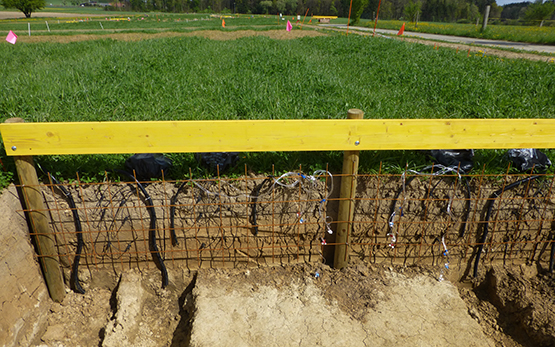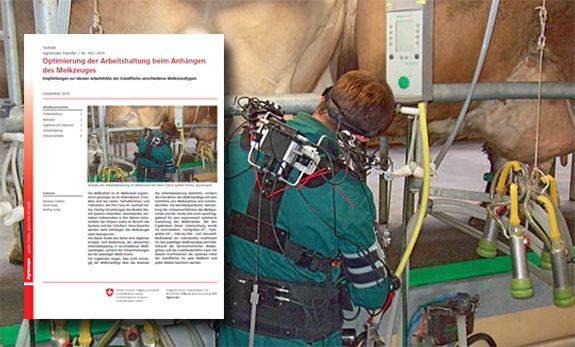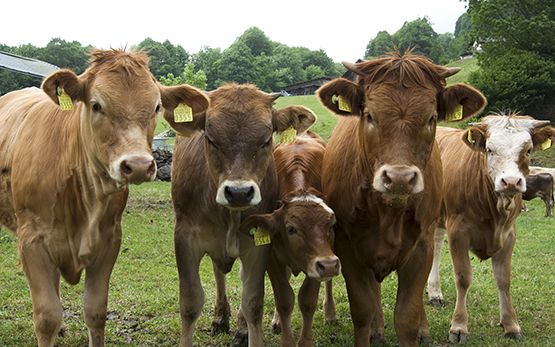Roder T., Pimentel G., Fuchsmann P., Tena Stern M., Von Ah U., Vergères G., Peischl S., Brynildsrud O., Bruggmann R., Bär C.
Scoary2: rapid association of phenotypic multi-omics data with microbial pan-genomes.
Genome Biology, 25, 2024, 1-19.
Eichinger J., Reiche A.-M., Münger A., Fuchsmann P., Pimentel G., Huber K., Dohme-Meier F.
Investigation of the suitability of exhaled volatile organic compounds to discriminate different diets in lactating dairy cows.
In: GfE Tagung. 5-7 March, Hrsg. GfE, Göttingen. 2024.
Bär C., Vergères G., Von Ah U., Pimentel G., Fuchsmann P., Blaser C., Macpherson A. J., Ganal-Vonarburg S. C., Sattari Z., Fernandez Trigo N., Bruggmann R., Roder T., Christensen S.
PolyFermentHealth-Projekt: Herstellung von funktionellen Lebensmitteln durch Fermentation.
In: Liebefelder Milchtagung. 28. November, Hrsg. Agroscope, Bern. 2023.
weitere Sprachen: französisch
Badertscher R., Pimentel G., Blaser C., Noth P.
A simple, rapid and validated method for the determination of free volatile carboxylic acids in cheese by GC-FID.
Chimia, 77, (9), 2023, 622.
Roder T., Pimentel G., Fuchsmann P., Tena Stern M., Von Ah U., Vergères G., Peischl S., Brynildsrud O., Bruggmann R., Bär C.
Scoary2: Rapid association of phenotypic large metabolomic datasets with the pan-genome of 44 Propionibacterium freudenreichii.
In: Agroscope Bioinformatics Symposium. 16 May, Hrsg. Agroscope, Zürich. 2023.
Eichinger J., Reiche A.-M., Münger A., Pimentel G., Fuchsmann P., Huber K., Dohme-Meier F.
Verwendbarkeit volatiler organischer Verbindungen in der Ausatemluft im Vergleich zu anderen biologischen Matrizen zur Identifikation ernährungsspezifischer metabolischer Profile von Milchkühen.
In: Schweizerische Vereinigung für Tierwissenschaften Tagung. 19. April, Zollikofen. 2023.
Eichinger J., Reiche A.-M., Münger A., Pimentel G., Huber K., Dohme-Meier F.
Usability of semi-volatile organic compounds from different biological matrices for identification of diet specific metabolic profiles in dairy cows.
In: Proceedings of the Society of Nutrition Physiology. 7.-9. March, Hrsg. Gesellschaft für Ernährungsphysiologie, Göttingen (DE). 2023.
Li K. J., Pimentel K. J., Brouwer-Brolsma E., Blaser C., Badertscher R., Pimentel G., Portmann R., Feskens E., Vergères G.
Identifying plasma and urinary biomarkers of fermented food intake and their associations with cardiometabolic health in a dutch observational cohort.
Journal of Agricultural and Food Chemistry, 71, (10), 2023, 4426-4439.
Bütikofer U., Badertscher R., Blaser C., Fuchsmann P., Tena Stern M., Kuert P. A., Pimentel G., Pimentel K. J., Vionnet N., Vergères G.
Serum and urine metabolites in healthy men after consumption of acidified milk and yogurt.
Nutrients, 14, (22), 2022, 1-23.
Roder T., Pimentel G., Bär C., Von Ah U., Bruggmann R., Vergères G.
Can eating bacteria from fermented foods support your health?
Frontiers for Young Minds, 10, 2022, 1-8.
Pimentel G., Roder T., Bär C., Sattari Z, Von Ah U., Fernandez Trigo N, Bruggmann R, Macpherson AJ, Ganal-Vonarburg SC, Vergères G.
Feeding germ-free pregnant mice with a fermented dairy product activating the Aryl hydrocarbon receptor increases postnatal intestinal group 3 innate lymphoid cells in pups.
In: Online NuGO week 2021 – 17th edition. Immuno-nutrigenomics: How to feed the immune system.. 06.09., Hrsg. NuGO, 2021, 1-17.
Pimentel K. J., Pimentel G., Hughes M., Michielsen C. J. R., Fatima A., Vionnet N., Afman L. A., Roche H. M., Brennan L., Ibberson M., Vergères G.
Discriminating dietary responses by combining transcriptomics and metabolomics data in nutrition intervention studies.
Molecular Nutrition & Food Research, 2021, 1-9.
Fuchsmann P., Tena Stern M., Münger L. H., Pimentel G., Burton K. J., Vionnet N., Vergères G.
Nutrivolatilomics of urinary and plasma samples to identify candidate biomarkers after cheese, milk, and soy-based drink intake in healthy humans.
Journal of Proteome Research, 2020, 1-15.
Pimentel G., Burnand D, Münger L. H., Pralong F. P., Vionnet N., Portmann R., Vergères G.
Identification of milk and cheese Intake biomarkers in healthy adults eeveals high interindividual variability of lewis system–related oligosaccharides.
Journal of Nutrition, 150, (5), 2020, 1058-1067.
Vionnet N., Münger L., Blaser C., Burton K. J., Pimentel G., Pralong F., Badertscher R., Vergères G.
Assessment of lactase activity in humans by measurement of galactitol and galactonate in serum and urine after milk intake.
American Journal of Clinical Nutrition, 109, 2019, 470-477.
Bütikofer U., Kuert, P., Vergères G., Freiburghaus C., Vionnet, N., Pralong, F., Burton K. J., Pimentel G., Badertscher R.
Postprandial changes of the serum metabolome after ingestion of probiotic yogurt and acidified milk.
In: 15th NuGO week. 3 September, Newcastle. 2018, 1.
Ulaszewska M.M., Weinert C.H., Trimigno A., Portmann R., Andres Lacueva C, Badertscher R., Brennan L., Brunius C., Bub A., Capozzi F., Cialiè Rosso M., Cordero C.E., Daniel H., Durand S., Egert B. und weitere
Nutrimetabolomics: An Integrative Action for Metabolomic Analyses in Human Nutritional Studies.
Molecular Nutrition & Food Research, online, (03 September), 2018, 1-38.
Münger L.H., Garcia-Aloy M., Vázquez-Fresno R., Gille D., Rosana A.R.R., Passerini A., Soria-Florido M.T., Pimentel G., Sajed T., Wishart D.S., Andres Lacueva C., Vergères G., Praticò G.
Biomarker of food intake for assessing the consumption of dairy and egg products.
Genes & Nutrition, 13, (26), 2018, 1-18.
Pimentel G., Burton K. J., Rosikiewicz M., Zangger N., Bütikofer U., Von Ah U., Voirol M.J., Aeby S., Delorenzi M., Gilbert G., Pralong F.P., Vionnet N., Portmann R., Vergères G.
A multi-omics’ approach to characterise the metabolic response to the ingestion of fermented dairy products in healthy men.
In: Agroscope PhD/Post-Doc Symposium. 13.09., Hrsg. Agroscope, Reckenholz. 2018, 1.
Pimentel G., Burton K. J., Von Ah U., Bütikofer U., Pralong F.P., Vionnet N., Portmann R., Vergères G.
Metabolic footprinting of fermented milk consumption in serum of healthy men: Metabolic footprinting of yogurt intake.
Journal of Nutrition, 148, (6), 2018, 851-860.








